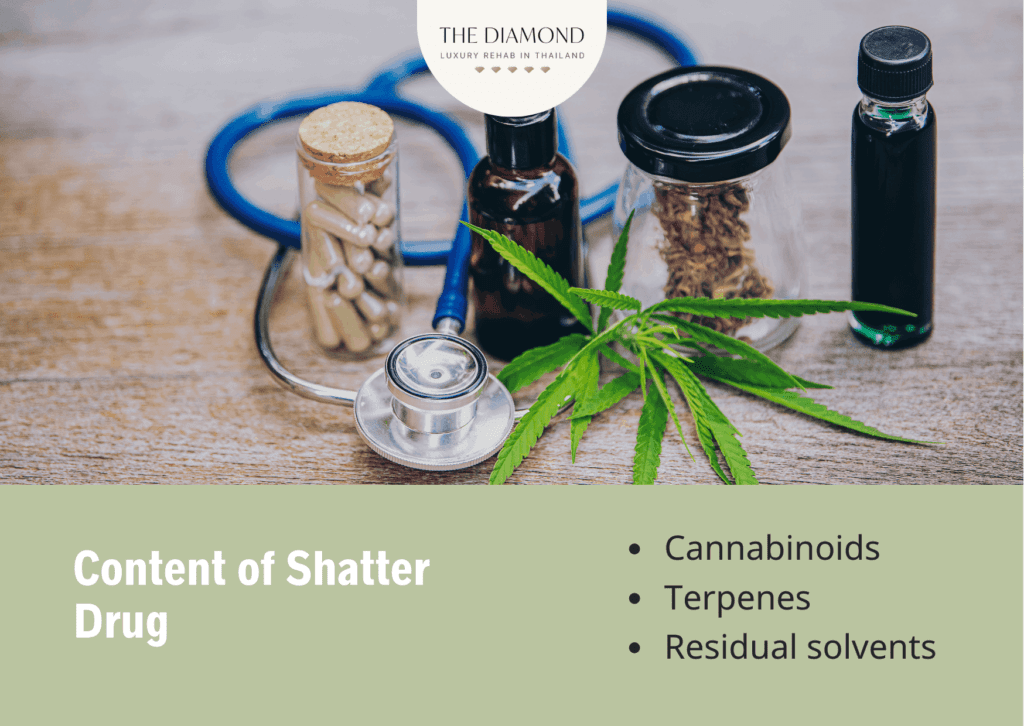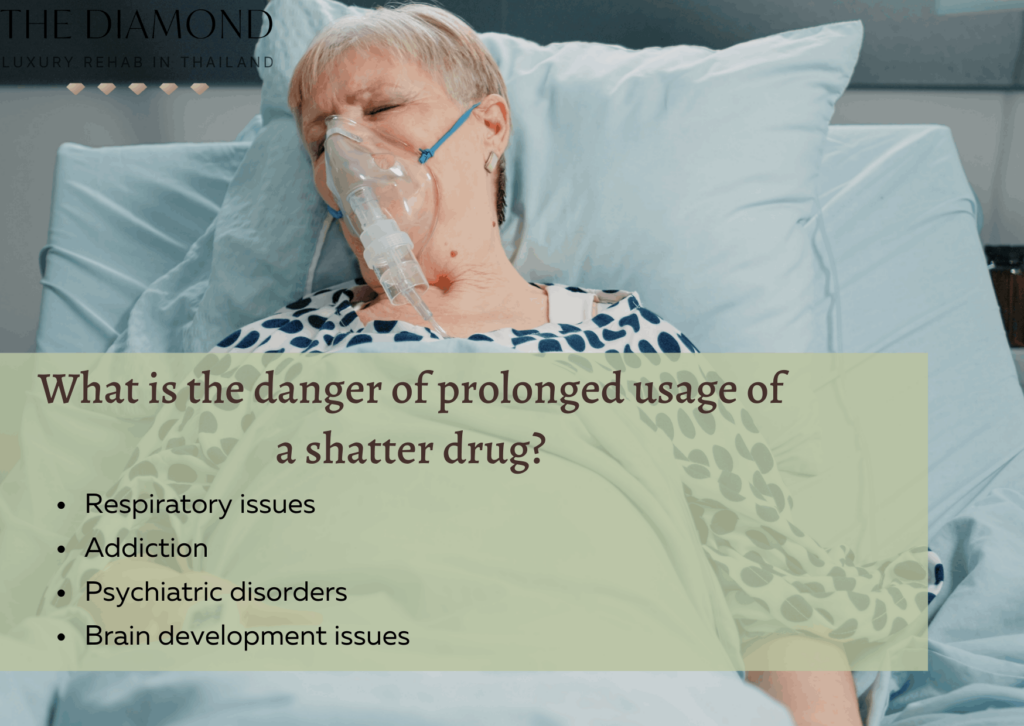Shatter drug: definition, contents, and effects

Shatter drug is a concentrated cannabis extract that is known for its glass-like texture and high potency. It contains a staggeringly high amount of tetrahydrocannabinol (THC), making the drug extremely addictive with severe effects.
Shatter is mainly composed of active compounds, such as cannabinoids and terpenes. But, it can also contain residual amounts of solvent (usually butane), which is used during the extraction process.
Shatter can cause various effects, including feeling euphoric and relaxed. It can also alter a person’s mood, thoughts, and perception. Although, it also has some serious side effects, including increased heart rate, anxiety, and even psychosis.
What is shatter drug?
Shatter is the colloquial name for a form of butane hash oil (BHO). It is a potent liquid concentrate of the cannabis plant, according to a 2018 article written by Al-Zouabi et al. and published in the Substance Abuse and Rehabilitation Journal.
The term “shatter” is derived from the ritual of breaking or “shattering” the thin stabilized liquid sheet into tiny pieces to be smoked or vaporized. Shatter has several street names, including butane hash oil (BHO), hash, marijuana wax, honeycomb, dab, budder, and sap. The nickname typically depends on the consistency of the product.
What is the history of shatter drug?
Shatter usage can be traced back to the 1960s, although it is believed that similar cannabis extracts have been around long before that. In his 2005 book titled Cannabis: A History, Martin Booth wrote that soldiers during the Vietnam conflict (1955 – 1975) would use petrol or acetone as a solvent and extract THC (tetrahydrocannabinol) from cannabis plants.
What does shatter drug look like?
Shatter appears as a thin hard sheet that can easily “shatter” or break into smaller pieces. After the THC extract is heated, the drug is in a liquid form. This is then left to cool off and stabilize, resulting in a thin hard sheet (similar to glass).
The color of the cannabis extract can vary from light brown to light yellow, depending on the extraction method and temperature.
According to a 2019 article published by the Drug Enforcement Administration (DEA), this extraction process is very dangerous since butane is highly flammable. There have been fires and explosions in cases where the butane caught fire.
THC (tetrahydrocannabinol) and CBD (cannabidiol) are both cannabinoids found in the cannabis plant. THC is a psychoactive component of the plant, meaning it can cause a person to experience a high. CBD, on the other hand, is not psychoactive and has recently become legal in some states, according to the Centers for Disease Control and Prevention.
How strong is shatter drug?
Shatter is quite potent and can quickly cause psychoactive effects once ingested (smoked, inhaled, or vaporized). This is due to the high THC content found in the cannabis extract.
According to a 2023 article published by the Alcohol and Drug Foundation, various factors influence how people feel the effects of drug use, regardless of the ‘strength’ of the drug.
How much THC does shatter drug contain?
Shatter is characterized by its high THC content of approximately 80%, according to the Alcohol and Drug Foundation. In comparison, the average THC content of dried cannabis is 15%, according to a 2023 update to a Cannabis informational article published by the Canadian Government.
The high THC content is part of the reason why shatter and other forms of cannabis extracts have become popular in recent years. As the THC content increases, the person will feel the effects of the drug more quickly after ingestion.
According to Marijuana Facts, an increased THC and potency of a drug could cause unexpected negative side effects and a possible risk of dependency on the drug.
Anxiety, paranoia, and psychosis are all possible negative effects of being exposed to high levels of THC, according to the National Institute on Drug Abuse.
In a 2016 case study published in the Schizophrenia Research Journal, Pierre et al. raises concerns about cases linking ‘dabbing’ (using shatter) and the development of psychotic disorders.
What is the content of shatter drug?

Shatter only has three main components which are listed below:
- Cannabinoids: Active compounds found in the cannabis plant that are responsible for drug effects. THC is the most common cannabinoid found in shatter.
- Terpenes: An aromatic compound found in the cannabis plant, which contributes to the flavor and aroma of shatter.
- Residual solvents: Trace amounts of solvents (usually butane) can also be expected due to the extraction process used.
How is shatter drug made?
The process of making shatter includes soaking cannabis in a solvent to extract the active compounds and heating this liquid extract to remove the residual solvent. The procedure of making shatter is listed below:
- The cannabis plant should first be ground and left to sit for a few hours to dry out.
- Take a ‘honey oil’ extractor tube and tightly pack the dried cannabis inside.
- Pour the liquid solvent (usually butane) over the cannabis to extract the terpenes and cannabinoids from the plant.
- At the bottom of the extractor, the tube should have a filter that will keep all the unwanted plant materials in the tube and allow the butane and cannabinoid mixture to flow through.
- Take the resulting extract outdoors or to a well-ventilated area and apply heat to remove as much residual solvent as possible. You can boil the mixture by placing it in a container over an electric heat source (do not use gas). You will know that the shatter is in its true form when the liquid stops bubbling over the heat – this indicates that the butane has evaporated. This step should be approached with care since butane is highly flammable.
- Scrape the extract onto parchment paper. Thereafter leave it to cool off and stabilize into a thin sheet, which is said to look like a honeycomb or glass.
- The stabilized drug is then “shattered” into pieces and smoked, inhaled, or dabbed.
What is BHO in shatter drug?
BHO (Butane Hash Oil) refers to any cannabis extract that is made using butane as a solvent. BHO can be found in various consistencies and forms, one of which is shatter (a hard and solid substance), according to the DEA resource, Get Smart About Drugs.
What is the effect of shatter drug on a person?
After a person smokes or ingests shatter, they are most likely to experience altered senses (taste, sight, etc.), altered sense of time (time slows down or speeds up), difficulty with thinking, hallucinations, and even psychosis. It typically generates a feeling of being ‘high,’ according to Cannabis Drug Facts, published by the National Institute on Drug Abuse.
Vertava Health explains that shatter usage can lead to an increased heart rate and blood pressure issues. The use of cannabis has also been linked to mental disorders, such as anxiety, depression, and schizophrenia.
However, it is important to note that no two people will experience the drug’s effects exactly the same. Factors such as genetics, age, and tolerance could influence how a person feels the effects after taking shatter.
Does shatter drug have the same effects as marijuana or weed?
While both shatter and marijuana are derived from the same cannabis plant, there are differences in the effects that they can cause. Shatter typically has a much higher THC content than marijuana, making the effects much more severe. Not only are the effects of shatter more severe, they are also longer-lasting, according to the National Institute on Drug Abuse.
Butane Hash Oil (BHO), and the forms thereof, is associated with a higher physical dependency, according to Madeline H Meier and her 2017 article published in the Drug and Alcohol Dependence Journal.
Although according to an article published by Al-Zouabi et al. in the 9th volume of the Substance Abuse and Rehabilitation journal, some users prefer taking cannabis extracts due to the stronger effects they can cause.
What is the danger of prolonged usage of a shatter drug?

The dangers of prolonged usage of shatter are listed below:
- Respiratory issues: Frequent use of shatter could result in a damaged respiratory tract and chronic bronchitis or an increased risk for pneumonia.
- Addiction: Shatter is highly addictive, so prolonged use increases the likelihood of someone developing an addiction and becoming dependent on the drug.
- Psychiatric disorders: Prolonged shatter use greatly increases a person’s probability of developing psychosis or other psychiatric disorders.
- Brain development issues: Exposing adolescents to prolonged shatter use greatly impacts their brain development with regard to memory and impulse control.
In a 2019 article written by Anderson and Zechar, published in the respiratory medicine case reports journal, a case is presented of an 18-year-old female who had used a form of butane hash oil recreationally. She came into the emergency room complaining of shortness of breath. After extensive tests, she was diagnosed with severe pneumonitis with acute hypoxic respiratory failure secondary to Butane Hash Oil inhalation.
What are the characteristics of a person who took shatter drug?
The characteristics of a person who took shatter are listed below:
- Bloodshot eyes
- Lethargy (slow movements and slow reaction time)
- Increased cravings for snacks
- Unusual talkativeness
- Confusion and lack of focus
Is there a treatment for users of shatter drug?
Yes, there are behavioral treatments available to treat a person who is addicted to shatter or other forms of Butane Hash Oil (BHO). According to the National Institute on Drug Abuse, these treatments include cognitive-behavioral therapy, contingency management, and motivational enhancement therapy.
A person who is addicted to the shatter drug can also enroll in a rehabilitation center, such as The Diamond Rehab Thailand.

